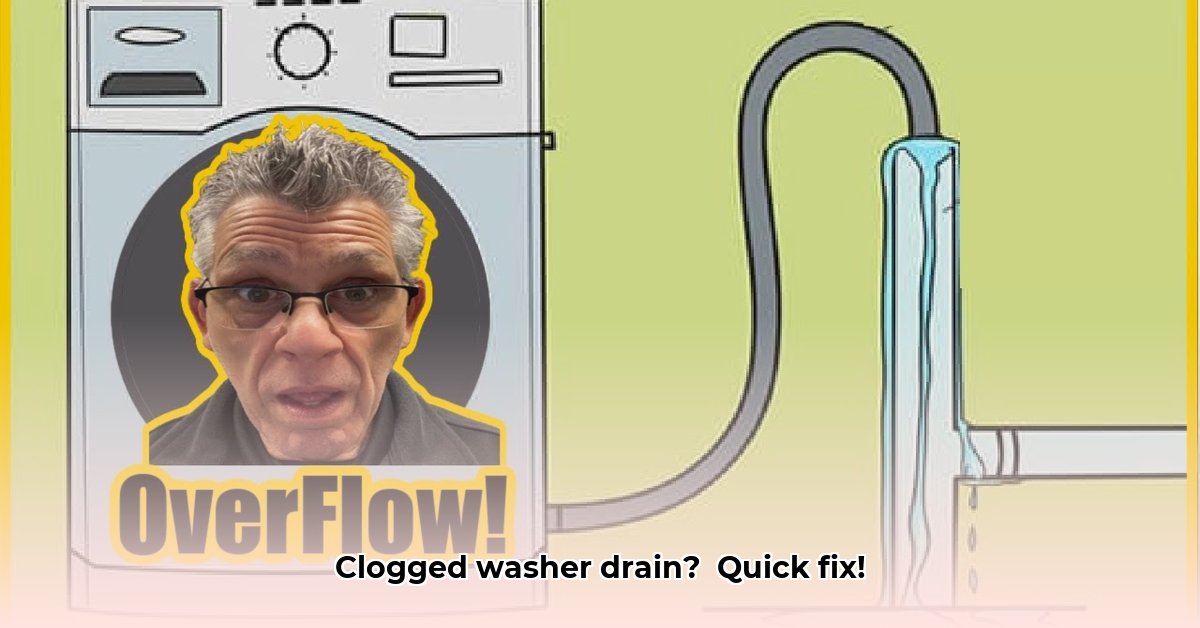Washing machine overflowing? Ugh, that’s a pain! But don’t worry, fixing a clogged washer drain is often easier than you think. This guide will walk you through everything from simple fixes to more involved solutions, so you can get your laundry back on schedule without calling a pricey plumber. We’ll cover common problems like lint buildup and hose issues, showing you how to clear the clog yourself, step-by-step. We’ll even share tips to prevent future clogs, saving you headaches (and money!) down the road. Let’s get that drain flowing again! For more on chemical drain cleaners, check out [this comparison](https://turthledeep.com/liquid-plumr-vs-drano/).
Washer Drain Pipe Clogged: A Fast DIY Guide
Ugh, a clogged washing machine drain – the worst! But don’t despair, fellow homeowner. This is a common problem, and often easier to fix than you might think. Let’s get that water flowing again! Discover quick solutions for washer drain pipe maintenance and home plumbing repair.
Identifying the Culprit: Is it a Clog, a Kink, or Something Else?
Before diving in, let’s do some detective work. Is the water draining slowly, or is it backing up completely? Is there a gurgling sound coming from the drain? These clues can help pinpoint the problem. Also, consider when the problem started. Did it happen after washing a particularly lint-filled load, or after moving the machine? Identifying these potential causes can make troubleshooting much easier.
Quick Fixes for Minor Clogs and Common Issues
For those slow-draining situations, or if you suspect a simple problem, let’s try some easy solutions first. These are quick fixes that may solve your problem in a jiffy.
-
Check the Drain Hose: Seriously, don’t skip this step. Is your drain hose kinked, squished, or somehow blocked? Sometimes a simple bend is enough to create a backup. Straighten it out, make sure it’s not twisted, and ensure it’s properly inserted into the standpipe. The general recommendation is about 6-7 inches into the standpipe, with a ½-inch gap allowing for airflow. A poorly positioned or damaged hose is a surprisingly common culprit for a clogged washer drain! You should also check for any visible cracks or damage to the hose itself. Replace it if necessary.
-
The Hot Water Flush: This is the easiest and quickest method. Sometimes, a little heat is all it takes to melt away minor clogs, like soap scum or small bits of lint. First, ensure the drain hose is securely in place. Then, carefully pour a gallon of hot (but not boiling) water directly down the drainpipe. Let it sit for about 10 minutes, then run a short rinse cycle on your washing machine with hot water to flush out any loosened debris.
-
Baking Soda and Vinegar – The Dynamic Duo: This classic cleaning combo is a safe household solution for many drain issues. Remove any standing water from the washing machine drum. Pour one cup of baking soda (sodium bicarbonate) down the drain, then slowly add one cup of vinegar (acetic acid). You’ll see a fizzy reaction – that’s the magic at work! Let this sit for about 30 minutes to loosen up the clog, then flush with hot water. For extra cleaning power, you can follow this with another hot water flush as described above. It’s surprisingly effective for many minor clogs related to drain blockage.
Tackling Stubborn Clogs: When Simple Doesn’t Suffice
If those simple fixes didn’t do the trick, we’ll need to move to slightly more advanced techniques. While still DIY-friendly, these methods require a bit more elbow grease, and maybe a little more caution to ensure effective drain cleaning solutions.
-
The Mighty Drain Snake (aka Auger): This inexpensive tool is a lifesaver. Disconnect the drain hose from the standpipe. Gently feed the snake down the drain, rotating it slowly to break up the clog. The goal is to grab onto the blockage and pull it out. When you feel resistance, carefully rotate the snake and try to break up or dislodge the clog. Once you’ve cleared the blockage, pull the snake out slowly and clean off any debris. Remember to be gentle to avoid scratching or damaging your pipes. If you’re not sure how to use one, there are plenty of videos online that can give you a quick tutorial. After snaking, flush the drain with hot water.
-
Check the Washing Machine’s Filter: Many washing machines have a filter designed to catch lint and debris before they enter the drain system. Consult your owner’s manual to locate the filter (it’s often behind a small access panel on the front or side of the machine). Remove the filter and clean it thoroughly, rinsing away any accumulated lint, hair, or other debris. Reinstall the filter securely before running your washing machine again.
-
Shop Vacuum: If you still find standing water, remove it with a wet/dry shop vacuum. This can prevent additional mess when working on the drain.
-
Commercial Drain Cleaners (Proceed with Extreme Caution!): Chemical drain cleaners should be considered a last resort. They can work, but they are harsh chemicals and can damage your pipes if misused. They can also pose a risk to your health and the environment. Never mix different types of drain cleaners, as this can create dangerous fumes. Always wear gloves and eye protection when using chemical drain cleaners. Always follow the instructions carefully, ensure adequate ventilation, and use them sparingly. They’re powerful stuff, and it’s best to use them only as a last resort before calling in the professionals to handle your washer drain maintenance. After using a chemical drain cleaner, flush the drain thoroughly with water as directed on the product label.
When to Call the Plumbing Pros: Knowing When to Ask for Help
If you’ve tried everything above and your washer is still stubbornly refusing to drain properly, it’s time to bite the bullet and call a plumber. Severe clogs, recurring problems, or any signs of significant plumbing damage (like leaks, cracks, or water damage) are signs that you need expert help. It is important to call a licensed plumber for these problems to ensure the job is done right and to avoid further damage during drain blockage repair. A plumber can also use specialized equipment, such as a video camera, to inspect the drain line and identify the cause of the clog.
Preventative Measures: Preventing Future Clog Nightmares
A little preventative maintenance is your best defense against future drain disasters. Here are some simple things you can do for washer drain prevention:
- Regular Cleaning is Key: Clean the lint filter in your washing machine every 4-6 weeks. You might be surprised by how much lint and debris build up! Set a reminder on your phone or calendar to make this a regular part of your laundry routine.
- Lint Trap is Your Friend: Make sure you’re using your dryer’s lint trap and empty it after each use. Those stray bits of lint can easily find their way into the washing machine drain. Consider using a mesh lint trap on your washing machine drain hose for added protection.
- Mesh Laundry Bags for Delicates: Protect your drain and your clothes by using mesh laundry bags for delicates and items that tend to shed a lot of fibers. This is especially important for items like sweaters, towels, and bedding.
- Use the Right Amount of Detergent: Using too much detergent can lead to soap buildup in your washing machine and drain line. Follow the manufacturer’s recommendations for detergent dosage, and consider using a high-efficiency (HE) detergent if you have an HE washing machine.
- Maintain Proper Hose Placement: Ensure the discharge hose is inserted into the drainpipe with at least half an inch of space around it. This gap helps prevent siphoning issues and promotes smooth drainage.
Risk Assessment of Clog-Busting Methods
Let’s take a quick look at the pros and cons of each method:
| Method | Effectiveness | Risk of Damage | Cost | Time Commitment |
|---|---|---|---|---|
| Hot Water | Moderate | Low | Very Low | 5-10 minutes |
| Baking Soda/Vinegar | Moderate | Low | Very Low | 30-45 minutes |
| Shop Vacuum | Moderate | Low | Low | 10-20 minutes |
| Commercial Drain Cleaner | High | Moderate | Low | 15-30 minutes |
| Drain Snake | High | Low | Low | 15-30 minutes |
| Professional Plumber | High | Low | High | Varies greatly |
Remember, preventing a clogged drain is way easier than dealing with one. Regular maintenance and a few smart habits can save you a lot of headaches (and money!) in the long run. Happy washing!
How to Unclog a Washing Machine Drain with a Slow Overflow
A slow-draining washing machine is frustrating. But before you call a plumber, let’s tackle this together! A slow overflow often signals a clog, not a major plumbing disaster. Let’s explore how to unclog a washing machine drain with a slow overflow and consider common drain problems.
Key Takeaways:
- Slow overflows usually mean a clog, not a broken pipe.
- Start with simple solutions like
- How to Stop Apps From Running in the Background to Boost Your - December 1, 2025
- How To Move Apps On Your Droid For Better Organization - November 30, 2025
- How to Move Apps on Android for Better Organization - November 29, 2025










